There is no true ‘off-season’ in the treasure trove that is the Galapagos Islands. Sitting on the Equator, there are two distinct seasons: warm and cool. An abundance of wildlife can be found year-round due to the exceptional number of endemic species; however, if you want to see a specific type of animal activity, we have picked some highlights from each month to help you tailor the best trip for you.
The Warm Season: December - June
Increased rainfall during the warm season transforms the islands into a verdant paradise. Despite this the coastlines still experiences blue skies and sunshine during the earlier months of the year. The sun and calm seas result in fantastic underwater visibility and warm waters from January to March, making this a perfect time of year for snorkelling.

Month by Month
December and the beginning of the year see a sharp increase in the number of Hammerhead Sharks and Manta Rays in the waters of the Wolf and Darwin Islands as water temperatures begin to rise.
In January, adult male Marine Iguanas transform in colour in order to attract a mate. The most spectacular pigmentation can be seen on the Islands of Espanola & Floreana, where the native iguanas turn a vivid green and red. Most of the eggs will hatch in May and vulnerable juveniles have to escape predators in order to survive, as depicted in the epic 'Iguana vs Snake' scene from David Attenborough’s Planet Earth.

Green Sea Turtles are particularly active in February as they arrive on the island shores to lay their eggs. Laying continues until April and the baby turtles begin to hatch in May, before making their treacherous journey across the beaches to the sea.
March is the height of the rainy season. The Magnificent and Great Frigatebirds inflate their imposing red neck pouches like balloons with the objective of attracting a mate (this can be seen until April).

April sees the arrival of the Waved Albatross to Española Island. Here, these birds with an impressive wingspan of up to 8ft, begin their courtship rituals, nest and lay eggs until they migrate in December.
North Seymour’s Blue-footed Boobies begin their famous two step dance of courtship in May and remain on land to look after young until August.

In June, you can see Giant Tortoises embark on their small but mighty migration from the lowlands to the lush highlands of Santa Cruz. Later in the year (December) they can be found doing the reverse, migrating to the highlands for the start of the rainy season.

The Cool Season: July – November
Sunshine still reaches the archipelago during the ‘Guara’ season but the heat is less intense with cloudier skies; mists often descend on the lowlands creating atmospheric sunrises. Although not as lush on land, the cool, dry season offers an abundance of opportunities to spot marine life. The Humboldt current strengthens meaning micronutrients are more plentiful, increasing marine activity. The trade-off here is cooler water temperatures and lower underwater visibility due to the plankton bloom, so it is a better time of year to scuba dive.

Month by Month
In July male lava lizards hit the gym, doing ‘push ups’ in order attract a suitable mate and ward off competition. This courtship behaviour lasts until November.
The gentle giants of the sea, Whale Sharks, can be found drifting around the coasts of Darwin and Wolf Island during August all the way through the cool season until November.
The cold season peaks in September with temperatures as low as 18 °C. Sea Lions are particularly active as breeding season kicks off; often males are seen fighting for dominance on lands and in the water

You have the best chances spotting whales and dolphins from September into October. If you are lucky then you may also catch a glimpse of a Humpback Whale migrating through the channel between the islands of Isabela and Fernandina.

Due to the recent mating season, November is the best time to see Fur Seal pups in their nurseries on the Genovesa and Santiago Islands. Galapagos, Californian and Fur Seals are often found playing aqua-aerobics next to snorkelers as they find their sea legs.
Use our guide to help you plan your travels, or alternatively, speak to one of our South America experts to plan an unforgettable trip to the Galapagos Islands.
